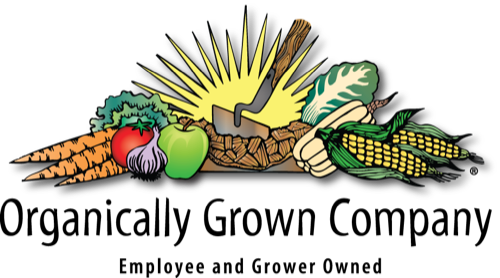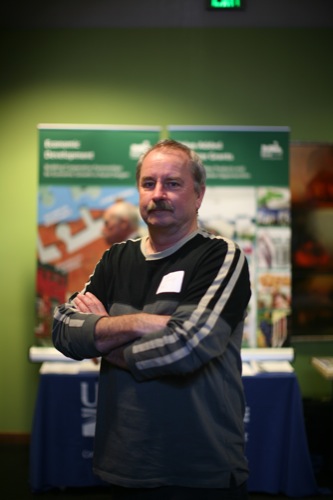 BY HANNAH WALLACE | OB BLOGGER
BY HANNAH WALLACE | OB BLOGGER
Demand for organic food continues to soar: Last year, sales of organic food rose to $32.3 billion — up 10% from 2012. In Oregon, organic produce wholesaler Organically Grown Co. has been championing organic growing methods for four decades.
 BY HANNAH WALLACE | OB BLOGGER
BY HANNAH WALLACE | OB BLOGGER
Demand for organic food continues to soar: Last year, sales of organic food rose to $32.3 billion — up 10% from 2012. Here in Oregon, organic produce wholesaler Organically Grown Co. has been championing organic growing methods for four decades. Founded as a cooperative in Eugene 36 years ago, OGC started with less than a dozen organic farms. “And some of those were big gardens!” recalls David Lively, one of the founders.
Though it became a for-profit company in 1983, OGC (like another local organic success story, Bob’s Red Mill) is also an ESOP, meaning its employees and member farmers are owner/shareholders. Today, the company has annual sales of over $125 million and employs around 250 people who work at the company’s Eugene, Portland, or Kent, Washington offices — or at its 120,000-square-foot distribution center in Gresham.
I sat down with Lively, who is now the company’s Vice President of sales and marketing, to ask him about the company’s growth, why it distributes New Zealand apples and South American bananas and the reason the Northwest is such an organic stronghold.
 OB: You’re an organic produce wholesaler—the company transports organic produce from farms to grocery stores, juice bars, and food buying clubs. But while you’re Northwest-based, you don’t only distribute regional produce. Can you explain?
OB: You’re an organic produce wholesaler—the company transports organic produce from farms to grocery stores, juice bars, and food buying clubs. But while you’re Northwest-based, you don’t only distribute regional produce. Can you explain?
DL: Even back in the ‘80s, we knew we had to source some produce from outside the Northwest. Some of the growers just wanted to move their stuff, but another group of us were like, “That leaves us with a serious predicament because we’re in Oregon and so we can only grow crops half the year. We’ll have nothing to do from November through April. What’s going to pay the rent?”
So we’re working with growers that are located all the way from British Columbia through the western United States to Mexico, South America, Hawaii, and even New Zealand. We have a full product line, pulling from all over the joint.
OB: You’re an S-Corp and an ESOP (Employee Stock Ownership Plan). What’s the difference between a farmer-owner and a farmer who merely has their produce distributed by you?
DL: Well, owners’ shares are worth value and so their shares increase as the company grows. We’ve got growers who, when they joined and put down $15,000 in the ‘80s, are worth tens of millions of dollars now. Owners vote for the board of directors and they may serve on the board of directors. At some point, they can retire and the business will buy their shares.
OB: How many growers do you work with, total?
DL: It’s hard to say because some of those growers are disguised behind brokers. We work with an outfit called Awe Sum Organics, which works with apple growers in New Zealand. We only bill Awe Sum, but they represent a lot of growers. Same with our banana deal: we only work with Organics Unlimited, but Mayra [Velazquez de Leon] represents growers who work in Southern Mexico. But I’d say about 240.
OB: And what’s the average size of the farms you work with?
DL: It varies a lot. From one acre to over 1,000.
OB: What’s the difference between your two brands—Organically Grown and Ladybug?
DL: Ladybug we created back in the ‘80s. It was Oregon-grown. Then we made it Oregon, Washington, and Idaho-grown. And then eventually we added British Columbia to it. So all that product is grown in one of those four entities.
Then we created Organically Grown. It was created because Fred Meyers wanted a 15-pound bag of juice carrots. We told them we’d come up with a brand for that and half the year we’d be pulling product out of the Northwest and the other half, we’ll get it out of California. Organically Grown is usually Northwest-grown but it’s possible that we’d pack stuff that’s not from the Northwest.
Then we decided to go Salmon Safe with Ladybug. Salmon Safe was a pretty big step—not every one of the growers could qualify. Some didn’t want to fill out more paperwork. Or there were issues with their practices or products. A lot of our growers became Salmon Safe, but the ones who didn’t, we pushed over to Organically Grown.
OB: Do you do anything as a business to recruit new farmers?
DL: We’re pretty focused on our sourcing. Most of our competitors have one or two buyers. We have half a dozen. We have a larger grower base than most of them do, too. And we’ll go to lengths to get product that most won’t. We do two tours a year where we fly buyers and sales people out to the farms. We’ve gone to New Zealand, Peru, Mexico, all over California and Washington and up to British Columbia. So we’re in the field a lot.
OB: So you are actively recruiting new people?
DL: Oh yeah, you have to. Wal-Mart says they’re going to get all the organic produce and Safeway wants it and Whole Foods wants it. Everybody wants it. Not everybody’s going to get it. Whole Foods alone says they’re going to triple the number of stores they’ve got. Our estimate is that we’re going to need four times as much produce as we’ve got now.
OB: So it’s a classic case of demand outstripping supply?
DL: Right now it is. Some of the off-shore crops—apples out of Chile and New Zealand—they just didn’t produce this year for various reasons. You’ve got a drought in California which is going to wreak all kinds of havoc.
OB: The organic sector is booming: the latest figures from the Organic Trade Association show sales of 33.3 billion in 2013—up 10 percent from 2012. Do you think the growth here in the Northwest is even more robust? And if so, what do you attribute that to?
DL: Portland, Seattle and San Francisco are all moving to organics big time. The co-op movement is very strong up here—at OGC we deal with at least a dozen co-ops—and the counterculture was big in Oregon and in Washington. (And the counterculture championed organics.) A lot of those young hippies who were buying organic with food stamps are walking into stores pretty well dressed now.
So I would say our organics movement is older and more sophisticated than in other parts of the country. The Puget Consumers Co-op (PCC) was created in 1953—the year I was born. They have 52,000 members! We would not be anywhere near what we are today if we had been anywhere else in the United States.
OB: There’s been a certain amount of backlash against USDA-certified organic food over the last few years, from the notion of “Big Organic” to the claim that organic produce has no more nutrients than conventional. But what about the fact that USDA organic standards allow for the use of organic pesticides—i.e. pesticides that are derived from natural sources? Which ones are used and are there any negative effects to humans?
DL: Well, they’re all essentially bio-degradable.
With pesticides, it’s all about persistence or lack of persistence. Once upon a time all farmers were using organic pesticides: Pyrethrum, rotenone, nicotine-based products, whatever. The problem was that none of them persisted long enough. You sprayed them and three days later they were useless. The whole point of conventional pesticides was to create something that stayed poisonous for a longer period of time.
The downside is that some of them persist forever. So you still have DDT in the soil. The organic ones are typically not nearly as toxic and they break down very rapidly.
Most organic farmers I know don’t use organic pesticides even if they can. If they do use them, they use them rarely. Organic farmers don’t want to be exposed to poison. They’re as freaked out about this shit as the consumer is! Most of them are attempting to create a bio-diverse system of creatures on their farm that when in balance will take care of those issues on their farm.
Hannah Wallace blogs on food and farms for Oregon Business.

